Getting featured by major publishers and journalists is massive for brand awareness, and the backlinks you get can transform your business - and help you get recommended in ChatGPT, too.
But, most people never bother with PR - mostly because they don’t know where to start.
At Endorsely, we’re an affiliate software that helps brands scale their promoters, track sales, and recruit affiliates to promote you all over the internet.
And, major publishers are a big part of growing an affiliate program - if you can land them.
I’ve been combining affiliate campaigns with digital PR for several years now - even before I built Endorsely to help other SaaS brands grow their affiliate programs.
Overall, JournoFinder is the best tool for finding journalists for your PR campaigns.
But these alternative options may work best for you. These are just my thoughts on the top tools for finding journalists, based on hundreds of hours of testing and experimenting with campaigns in our agency.
Quick Comparison: Finding the Right Tool for Your Needs
A Quick Intro: How Digital PR Works With Affiliate & Influencer Campaigns
Innovative affiliate managers and founders are now combining digital PR with their affiliate and influencer programs to amplify their reach and get even more customers and brand awareness.
For example, the UK recently banned under-18s from accessing “certain types” of content online, which led to a huge increase in VPN downloads.
If I was an affiliate manager for a VPN brand, I would firstly collect data on how much search volumes, trends, and traffic has increased, and prepare a data study. Then I’d contact all the journalists with this data study.
Then, I’d create a campaign for all the influencers and affiliates in our network, and give them this same data study and messaging angle on how this recent UK law is driving a huge amount of interest.
They would then promote this to their audience to drive even more awareness, which then leads to even more major news publishers picking up on the story, and further promoting our brand.
1. JournoFinder: Best Overall
Most journalist media databases are overpriced and cost $500+ per month, so if you’re not a PR agency, this is just too much to spend.
JournoFinder is like a lightweight version, but works really well.
You simply type in your keywords, and JournoFinder creates you a media list of the top journalists, and which outlets they are either working full-time for, or are freelance at.
Within minutes, you have a full list of 100+ journalists, with their emails, Twitter and Linkedin details.
Then, just export the CSV and use your email outreach tool to contact them with your PR pitch.
Rather than maintaining stale contact lists, the platform analyzes millions of fresh articles to identify journalists actively covering specific topics.
Search for "fintech startups" and you'll see reporters who published related stories this month, not contacts from 2019.
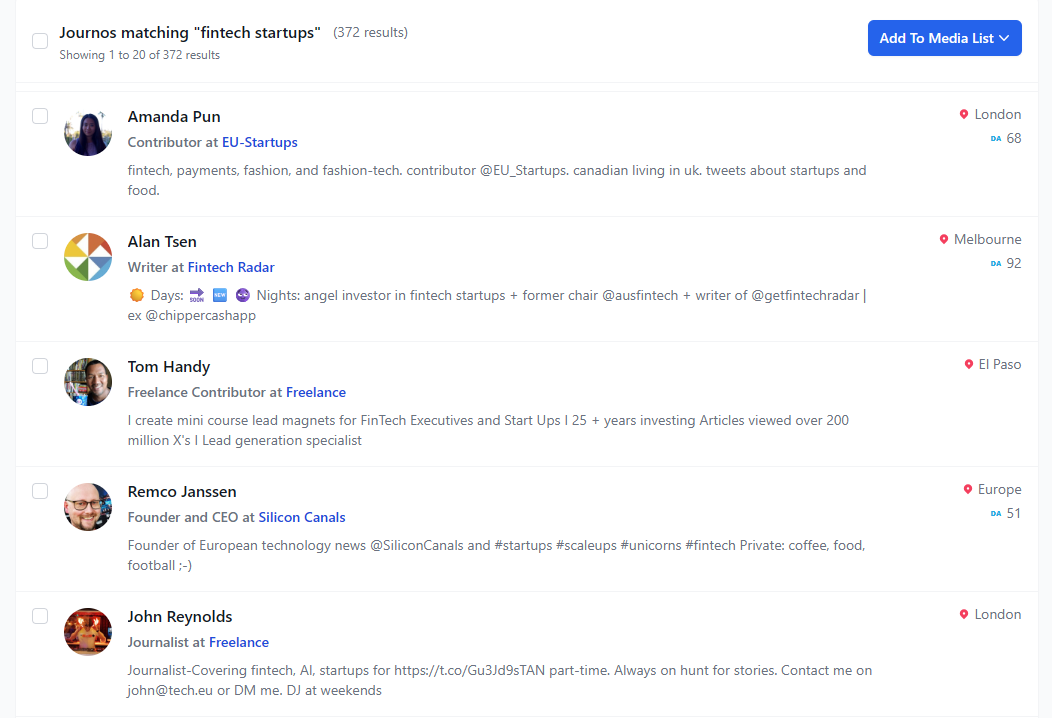
The email validation feature alone justifies the subscription. JournoFinder validates emails so you’re only sending to active journos, so you keep deliverability high and don’t risk getting your email domains or inboxes blacklisted.
If you’re building links and getting general features and expert quotes to increase your personal brand, they also have a JournoRequest Alerts system for whenever journalists are looking for experts to quote on their story.
Set up your alerts, and the tool emails you whenever a relevant pitch is posted, so you can reply ASAP and get featured in their story.
Instead of manually checking HARO, Featured, and similar platforms, I receive filtered notifications when journalists need sources in my expertise areas.
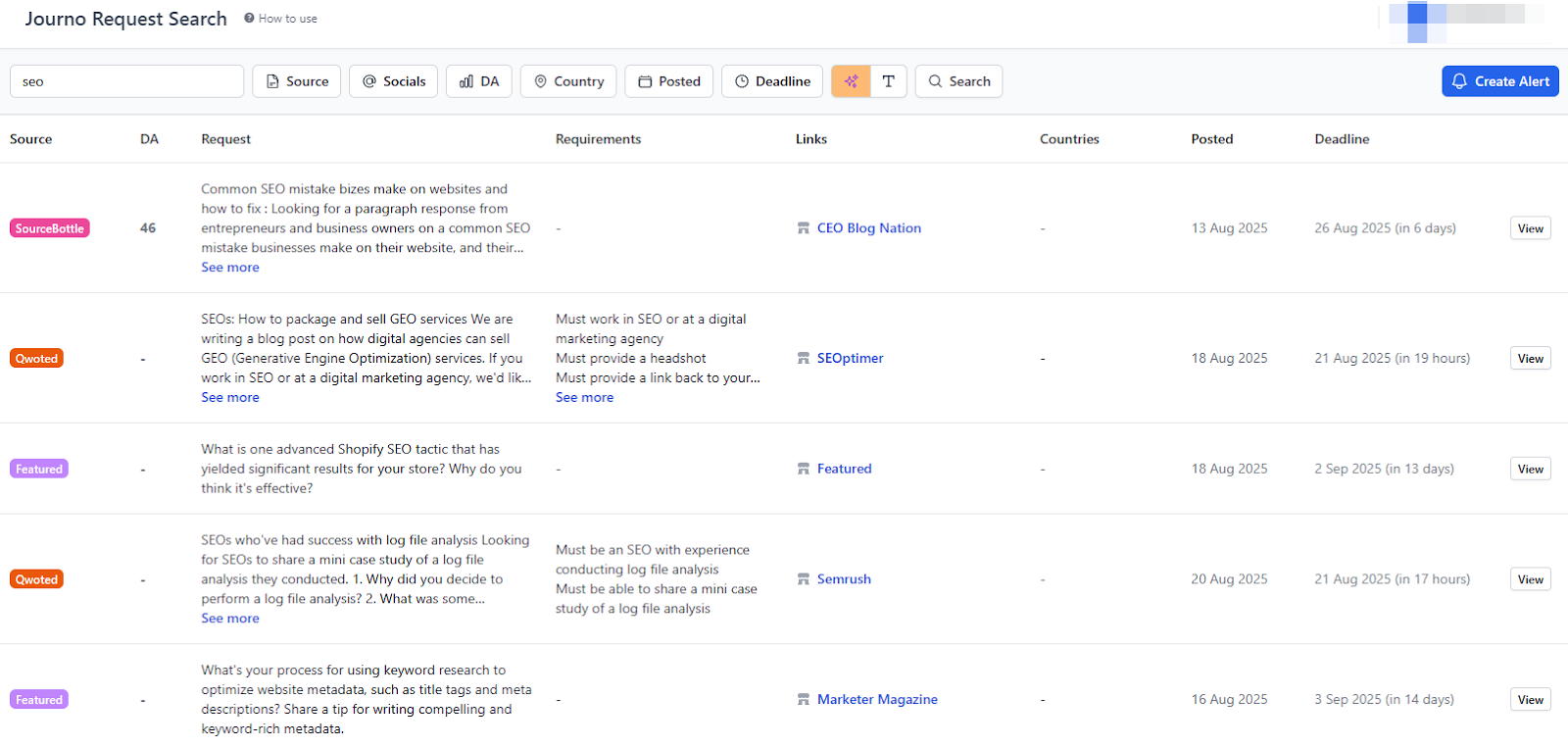
The 7-day trial removes all friction from testing the platform. No sales demos, no commitment – just immediate access to see if their journalist data matches your needs.
Pros:
- Live journalist tracking from current articles
- Verified contact information with bounce protection
- Automated source request monitoring
- Batch contact extraction from article URLs
- Budget-friendly pricing compared to enterprise solutions
- Risk-free trial without sales pressure
Cons:
- Database size smaller than legacy platforms
- Limited native email campaign features
- Fewer third-party integrations than established tools
Pricing: $189 monthly or $99 with annual billing. Includes a 7-day free trial.
Perfect for: Growing companies, agencies, and anyone prioritizing contact accuracy over database volume.
2. Cision: Very expensive, but good
While Cision isn't my first choice and I don’t actively use it because it is extremely expensive, certain situations make it the only option. If you’re a big agency and just need the best, you just kinda need it. But if you’re a brand looking to grow and get your first big features in major publications, it’s overkill.
Operating for over 100 years, Cision maintains contact information for journalists across 190 countries.
Their integration with PR Newswire creates a complete ecosystem for research, outreach, and press release distribution.
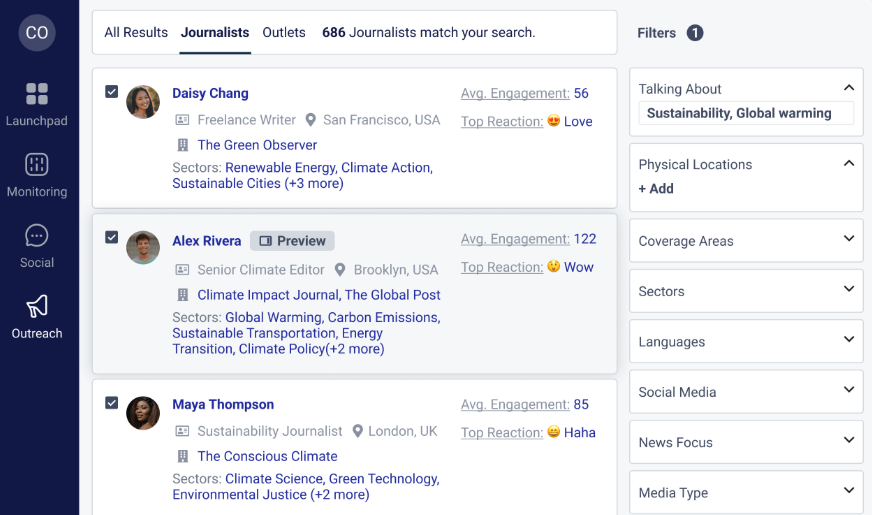
It is very good at finding journalists in markets where smaller tools have limited coverage.
If you need niche contacts for journos covering the automotive industry news in Eastern Europe, Cision is mostly likely to have them.
You can also outreach journalists within the platform, which saves time versus exporting the emails and outreaching them via your email, or an email outreach software.
Pros:
- Extensive international journalist database
- Integrated press release distribution capabilities
- Sophisticated filtering and analytics tools
- Established media relationships and credibility
- Comprehensive monitoring and measurement features
Cons:
- High cost barrier for smaller organizations
- Complex interface with steep learning curve
- Requires long-term contracts and setup investments
- Over-engineered for simple journalist discovery needs
Pricing: Custom pricing starting around $7,000 annually with additional feature costs.
Ideal for: Enterprise organizations, international campaigns, and teams needing comprehensive media intelligence alongside journalist contacts.
3. HARO (Help a Reporter Out): Free and good option for backlinks in press
Sometimes the best tool for finding journalists is letting them find you. HARO connects sources with reporters seeking expert commentary, quotes, and story angles.
Three times a day, you get an email with all the journo requests across dozens of topics.
It may not look pretty, but these are journalists actively looking for you to give them quotes and link to you, so it’s so much warmer than cold pitching them your story idea. Response rates naturally increase because journalists are looking for quotes, not the other way.
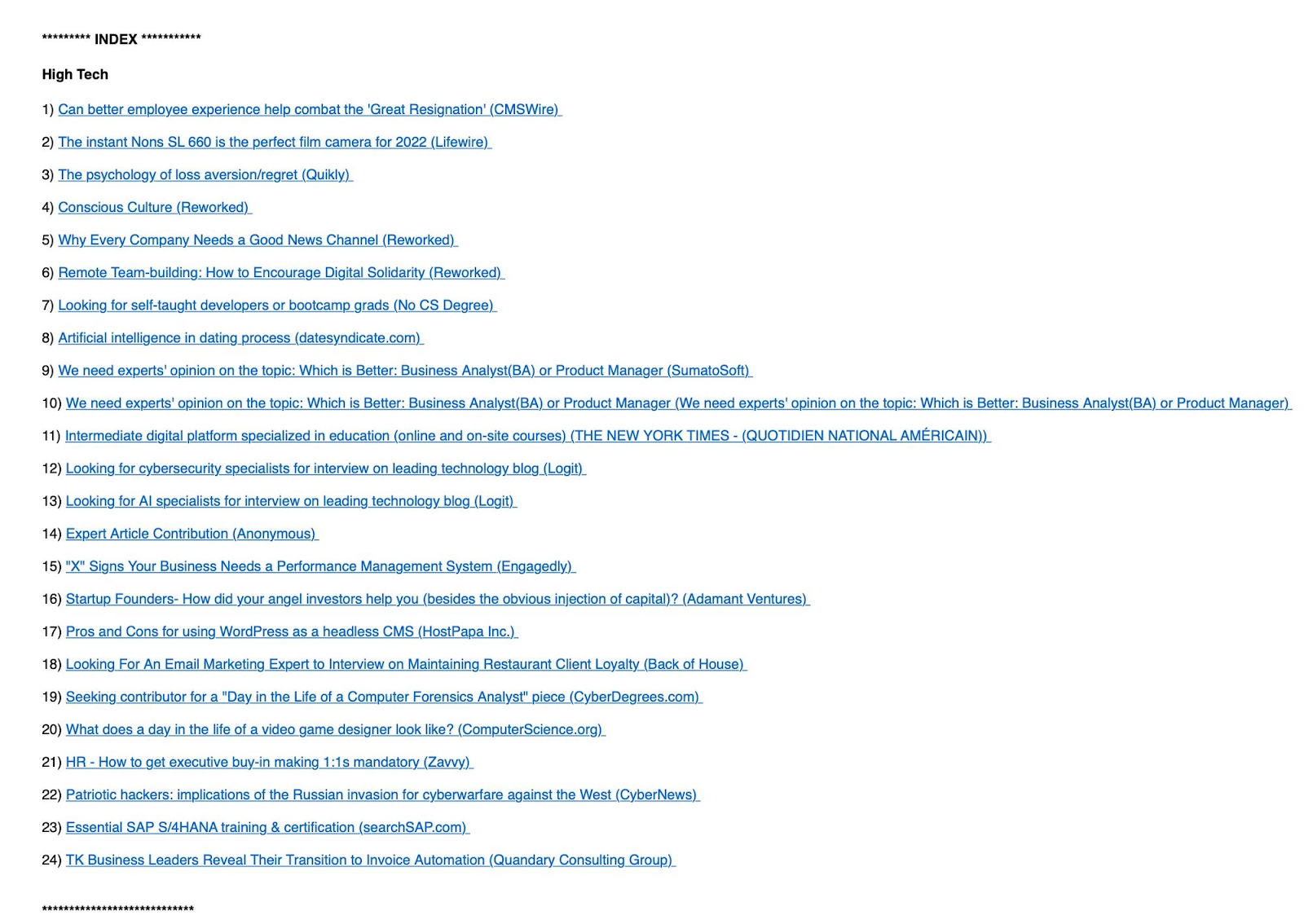
Success on HARO requires discipline and speed. Popular queries receive hundreds of responses, so timing and relevance determine visibility.
I've found that responding within the first hour significantly improves the chances you’ll get featured.
The platform's weakness is unpredictability. You can't control when relevant opportunities appear, and the limited number of pitch opportunities means it doesn’t scale to hundreds of backlinks or features - like a successful digital PR campaign can.
HARO works best as supplementary outreach alongside proactive PR pitching.
Pros:
- Completely free to use
- High response rates due to journalist-initiated requests
- Access to major publication opportunities
- Builds natural relationships through value-first interactions
- No cold pitching required
Cons:
- Unpredictable opportunity timing
- High competition for popular queries
- Limited to reactive rather than proactive outreach
- Requires consistent daily monitoring
- No contact information provided for follow-up
Pricing: Free for sources, paid plans available for journalists.
Best suited for: Subject matter experts, thought leaders, and anyone comfortable with reactive outreach strategies.
4. Muck Rack: Again, good but very expensive
If budget weren't a constraint, Muck Rack is another great option. They have a huge database of journalists, with extra business intelligence features to monitor social media and more, designed for modern PR workflows.
What distinguishes Muck Rack is contextual journalist information. Beyond email addresses, you'll find Twitter activity, recent articles, beat changes, and professional background details.
This context is very useful for personalizing pitches. For example, if you can see that a reporter recently covered work-from-home trends, it makes it a lot easier to frame your story about flexible office policies in a way that they would be interested in the story.
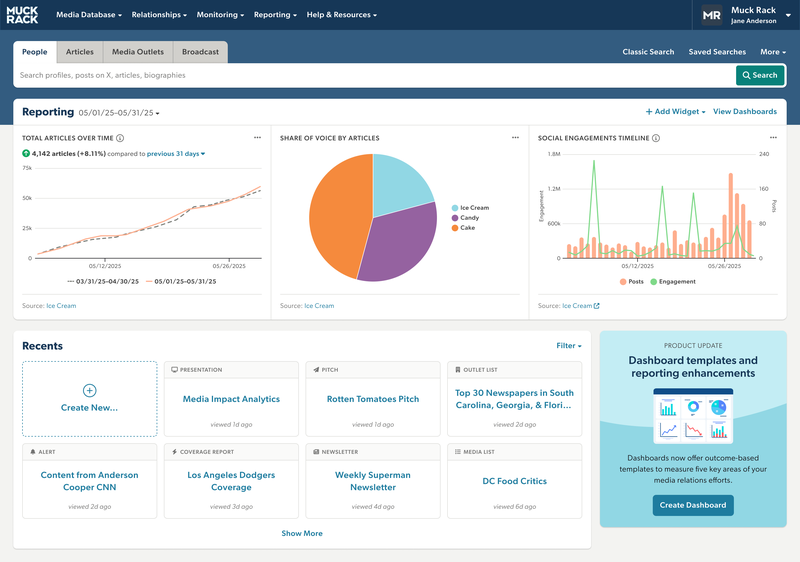
The platform's natural language search functionality understands complex queries like "journalists covering AI ethics at major tech publications" to surface precisely relevant contacts.
For PR teams, Muck Rack's collaboration features prevent any kind of embarrassing situation if multiple people on your team pitch the same journalist at the same time.
Pros:
- Rich journalist profiles including social media activity
- Advanced team collaboration and tracking features
- NLP search for better semantics
- Automated coverage monitoring and analytics
Cons:
- Premium pricing = it’s only useful for big PR teams, not smaller brands
- No free trial
- More complex to learn and use
Pricing: Approximately $5,000 annually for basic access, with team features increasing costs substantially.
Target audience: Mid-sized agencies, collaborative PR teams, and organizations prioritizing workflow efficiency.
5. Twitter/X Advanced Search: Free and lots of journalists are there
Most people overlook Twitter's advanced search as a way to find journalists. But, it's surprisingly effective for finding reporters covering specific topics. Journalists regularly share their work, seek sources, and discuss industry trends on the platform.
Using advanced search operators, you can find journalists who recently tweeted about your industry, identify reporters seeking expert sources, or discover writers covering competitors.
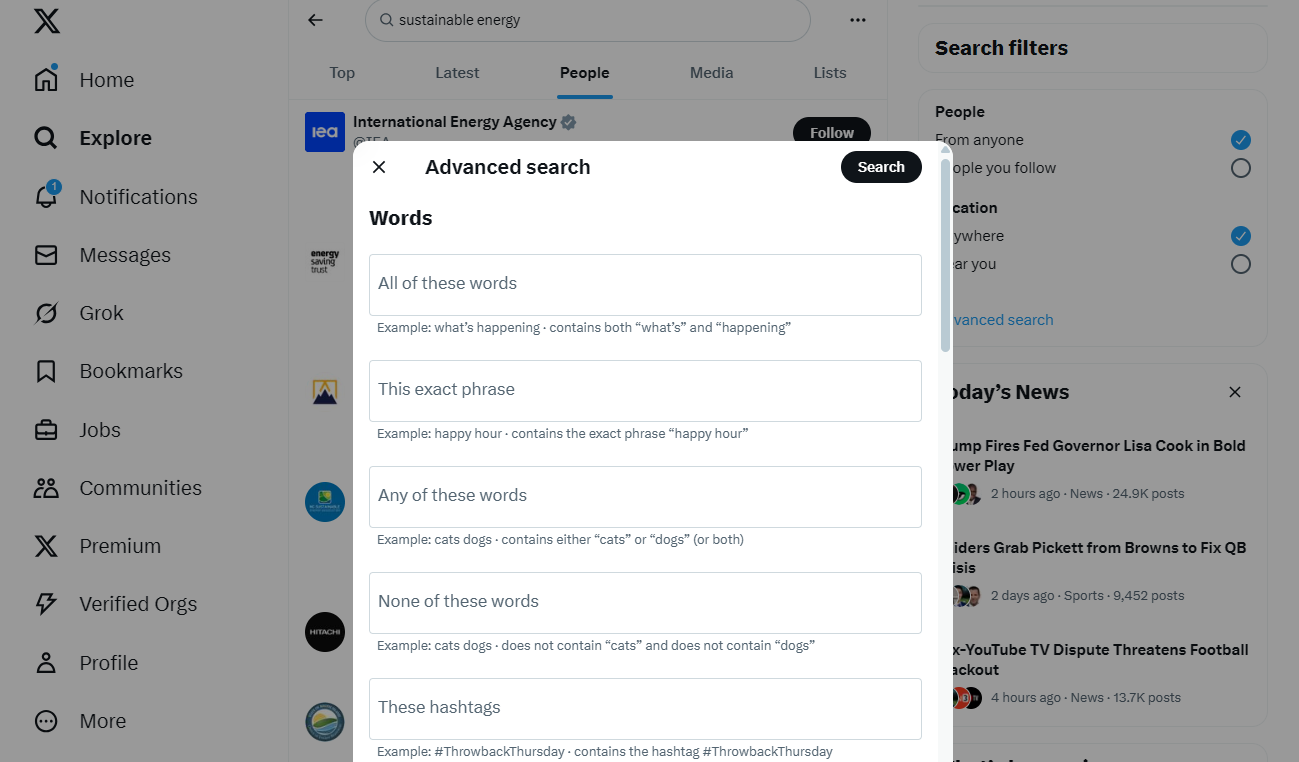
This is obviously limited, and you don’t get their emails by doing this. But, Twitter is an underrated source for finding PR opportunities and journalists needing quotes
Pros:
- Completely free
- Find journalists looking for your quotes
- Can DM them straightaway to offer your quote
Cons:
- Takes a lot of time, and manual research
- No emails
- Limited to journalists active on Twitter
- Doesn’t scale
Pricing: Free
Optimal for: Bootstrapped startups, solo practitioners, and anyone comfortable with manual research methods.
6. Hunter.io: The Domain-Based Email Discovery Tool
Sometimes you know exactly which publication you want to reach but need the specific journalist’s email.
Hunter.io excels at finding email addresses associated with specific domains, making it perfect for targeting journalists at particular outlets.
(Hunter is actually one of the APIs we use in Endorsely’s Affiliate Finder feature, which helps you find affiliate’s emails within our affiliate tracking software.)
The platform's domain search feature reveals all email addresses associated with a publication's website, along with confidence scores for each contact's validity. Search "techcrunch.com" and you'll discover not just general addresses, but specific reporter emails with verification status and source attribution.
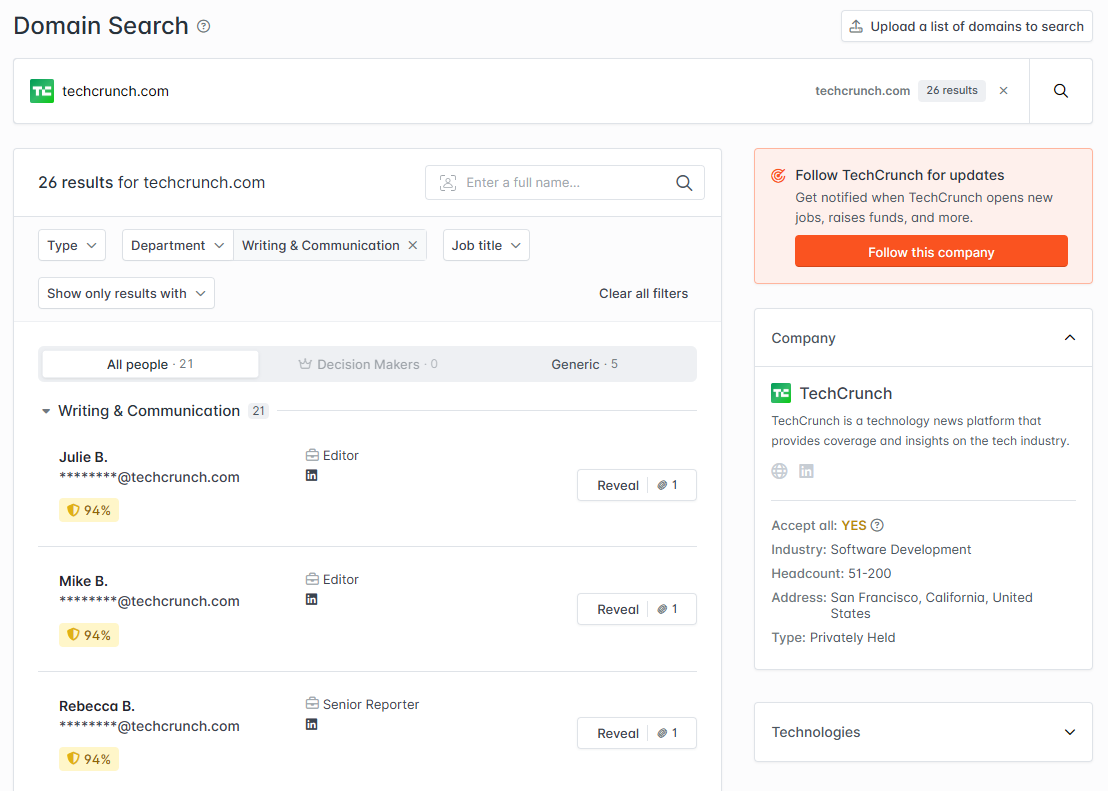
Hunter's email pattern recognition proves especially valuable for publications that follow consistent naming conventions. Once the platform identifies a pattern like "firstname.lastname@publication.com," you can apply this format to find contacts for journalists whose names you've discovered elsewhere.
The email verifier tool also saves you from bounces and deliverability issues. Before sending campaigns, you can run your contact lists through Hunter's verification system to remove invalid addresses.
While Hunter isn’t specifically for journalists or PR, it’s great for finding specific website email addresses for pitching. The free plan's generous monthly allowance makes it accessible for smaller campaigns.
Pros:
- High accuracy domain-based email discovery
- Built-in email verification and confidence scoring
- Pattern recognition for consistent publication formats
- Generous free tier with monthly credits
- Simple, straightforward interface
- Bulk email verification capabilities
Cons:
- No journalist-specific context or beat information
- Limited to email discovery without social media profiles
- Requires separate tools for pitch personalization
- Some publications block domain scraping
Pricing: Free plan includes 25 searches monthly. Paid plans start at $49/month for 500 searches.
Perfect for: Publication-specific outreach, email verification, and complementing other journalist discovery tools.
Which Media Database You Should Use
Here’s a framework to help you decide which tool is best for your PR needs:
Match tools to your outreach volume
If you're sending fewer than 50 pitches monthly, free tools like HARO and Twitter searches may suffice. Higher volumes demand automated solutions like JournoFinder or Muck Rack to save you time as you scale.
Prioritize data freshness over database size
Fresh contacts from 500 active journalists outperform stale information from 5,000 former reporters. Use tools with updated, fresh lists so you can reach real journalists looking for your story.
Test the tools with your specific topics
Some tools are better for some industries than others - so it depends on your niche. For example, Endorsely is a SaaS that helps other SaaS businesses grow their affiliate programs.
For us, JournoFinder is great and helps us find journalists talking about marketing, influencer and affiliate marketing, and SaaS-related topics.
But if you’re in a different industry, this might be different.
Factor in learning curve costs
Complex platforms with impressive feature lists may sit unused if your team lacks time for proper training. Sometimes the simpler tool your team uses immediately delivers better results than the sophisticated platform that overwhelms new users.
My Personal Strategy
Before building Endorsely to help SaaS companies grow their affiliate programs and track affiliate clicks and sales, I built other brands and used SEO and PR as major marketing channels.
I’ve spent years using these tools, and we now use these strategies to grow traffic and brands awareness to Endorsely.
I personally use JournoFinder for finding journalists to pitch to. I can create media lists in minutes, get all their emails, and export these into my email software to outreach them fast.
HARO (and other similar platforms like Qwoted, Featured, etc) supplements this with reactive opportunities where journalists seek sources matching my expertise. It’s free, so the only cost is your time writing the pitch. Don’t pitch AI slop though, it won’t get featured. Be authentic and try to help.
Frequently Asked Questions About Finding Journalists
How do I find journalists in niche industries?
Specialized publications and trade magazines often employ journalists who don't appear in mainstream databases. Use Twitter searches with industry hashtags, check bylines on trade publication websites, and monitor LinkedIn groups where industry journalists engage with sources.
How can you combine journalist PR campaigns with your affiliate and influencer program?
Whenever you have an angle you think major publications could cover for your brand, give the same data and information to the affiliates and influencers in your network.
They have big audiences, including journalists, and they can help grow a story (and send you traffic and sales) which can help get the story covered by even more publications, gaining you even more exposure.
What's the most effective way to verify journalist contact information?
Beyond email verification tools, check the reporter's recent articles to confirm current employment and beat coverage. Social media activity provides additional verification that contacts remain active and relevant to your pitch topics.
Should I focus on finding freelance journalists or staff reporters?
Both offer advantages: staff reporters provide consistent publication relationships but may have stricter editorial guidelines. Freelancers often have more flexibility in story selection but require verification of their current publication relationships.
How many journalists should I contact for each campaign?
Quality trumps quantity in journalist outreach. A targeted list of 25-50 highly relevant contacts typically outperforms mass pitches to 500 loosely related journalists. Focus on personalization and relevance rather than volume metrics.
What information should I collect about each journalist?
Beyond contact details, track recent article topics, preferred story formats, response patterns, and social media activity. This contextual information significantly improves pitch relevance and response rates over time.



